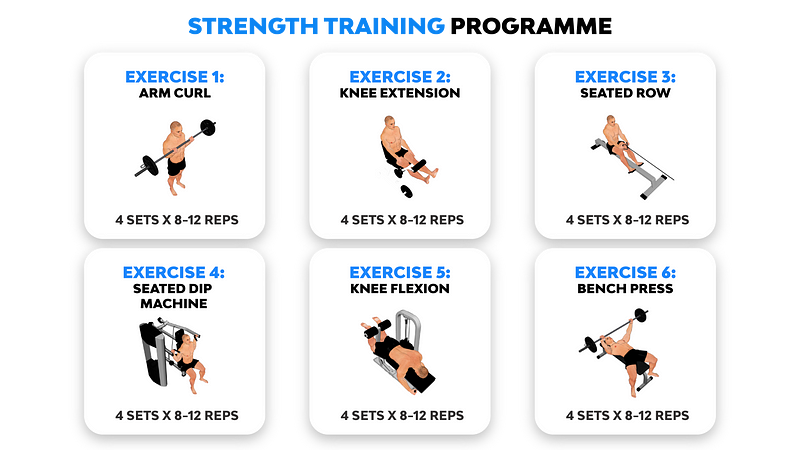One tip that can give you bigger muscles
Up until recently, there has never been scientific testing on the idea of inter-set stretching. Only a grainy picture of a PowerPoint slide from a conference that suggested a prospective study that showed improved hypertrophy rates from stretching between sets.

Ever signed up for a session of personal training before?
Well, if you have, you’ll realize that bodybuilding coaches often advise clients to stretch between sets to achieve maximum muscle hypertrophy. But it’s tiring enough, as it is when you have a trainer hovering around, and counting every rep you do.
Do you really have to perform inter-set stretching while drenched in sweat, and gasping for air?
Up until recently, there has never been scientific testing on the idea. Only a grainy picture of a PowerPoint slide from a conference that suggested a prospective study that showed improved hypertrophy rates from stretching between sets. Unfortunately, it was never published. Only its abstract remains, which is available here. Scroll down to #22 if you’re interested.
However, a recent study performed in early-2019 seems to suggest that bodybuilding coaches were right all along.
Research
The effects of inter-set stretching on both strength gains and hypertrophy in untrained men were examined.
The researchers sought to answer two primary questions with regards to the incorporation of inter-set stretching:
1. Would it lead to enhanced muscle growth?
2. Would it lead to more significant strength gains?
The investigators hypothesized that stretching between sets would lead to more significant muscle growth, but not have additive effects on strength gains.
Let’s find out if they were right.
Subjects

29 healthy, untrained men were rounded up for the study. More details on the involved men are included in the diagram below if you’d like to go more in-depth.
Methods

The men were randomly assigned to two groups, and both groups were put on the same full-body training program. They performed bench press, elbow extensions, seated rows, bicep curls, knee extensions, and leg curls for 4 sets of 8–12 reps to failure twice per week.
The only difference between the groups?
· Group 1 — Rested between sets.
· Group 2 — Stretched their prime movers (hamstrings if they performed leg curls, or biceps if they were doing bicep curls) between sets.
The researchers measured the men’s 1RM (One Rep Max) bench press and knee extensions before, and after the 8-weeks training program to monitor increases in strength gains. Which is very similar to a 6-week periodizationprogramme.
Muscle hypertrophy, on the other hand, was tracked through measurements of muscle thickness for the various muscle groups:
· Biceps
· Triceps
· Rectus femoris (quadriceps muscles)
· Vastus lateralis (another part of the quadriceps muscles)
Results
Muscle thickness in the quadriceps was found to be significantly increased in the inter-set stretching group when compared to the group that did not perform between-sets stretching.
And while changes in other outcome measures were not significant, the differences ultimately leaned in favor of the inter-set stretching groups. This is because a considerable increase in muscle thickness was observed when all four thickness measurements were taken as a sum.
Interpretation
I must highlight once again: there was only a significant hypertrophy difference in a single muscle — the vastus lateralis. Nevertheless, it is worth noting that the summed difference across all four muscles did reveal a sharp 50% increase in hypertrophy when inter-set stretching was involved.
It is quite possible that the research was simply underpowered, which led to the observed non-significance. But I can’t say for sure until more research is done.
How does inter-set stretching boost muscle growth?
Well, there’s nothing in the current scientific literature that can answer that. All we have now is mechanistic work in animals — nothing direct in humans. I see you’re already doubting the results of this study. After all, it’s just a single study, right?
Not so fast: these findings actually gel with a recent study that found significant calf muscle hypertrophy with just stretching. So, it seems like there is certainly something going on with stretching that causes muscle growth.
What, exactly? I’m not too sure, and I’m hoping for more research in the future.
Application
This is the most critical part: how can you apply what you’ve learned from this article to your gym routine? While the results of this study aren’t crystal clear, it definitely suggests that inter-set stretching can enhance muscle growth.
Unless you do supersets or circuits for all your training, you have to do something between sets. In my opinion, light stretching seems like a very viable way to spend that time.
I mean — what’s the worst that can happen? It might potentially not do very much for bigger muscles for you, but it can help keep you focused on your workout. You know, instead of falling down the rabbit hole of swiping past Stories after Stories on Instagram.

Convinced yet? If I’ve got you on my side now, the best way to implement inter-set stretching is to take inspiration from the protocol used in the study. Just 30 seconds of non-painful stretching between sets. Please note the words’ non-painful’. You don’t need to go through severe discomfort during stretching to see muscle growth.
In fact, it’s been shown that intense stretching before training can actually lead to less muscle growth. Also, holding stretches for a long time (60–90+ seconds) can acutely decrease force and power output. Yikes — not what you’d want when you head to the gym, right?
Conclusion
While the study we’ve examined doesn’t provide robust evidence in favor of interest stretching for growth, all of the results leaned in favor of doing light stretching between sets.
Personally, potentially improving your results by merely using your rest periods more efficiently seems like a no-brainer to me. Just remember to keep your stretches at a moderate intensity, and to limit them to 30 seconds each. You don’t want to hurt your gains by over-stretching!
Try it out today with GymStreak’s app! Track the progress of your active workout sessions and get a clear view of your rest periods with the app’s in-built countdown timer. Use your time more efficiently by stretching every time your AI-powered workout trainer tells you to rest.

Well, what are you waiting for?
Get GymStreakReferences
Behm, D. G., Blazevich, A. J., Kay, A. D., & McHugh, M. (2016). Acute effects of muscle stretching on physical performance, range of motion, and injury incidence in healthy active individuals: a systematic review. Applied Physiology, Nutrition, and Metabolism = Physiologie Appliquee, Nutrition Et Metabolisme, 41(1), 1–11. https://doi.org/10.1139/apnm-2015-0235
Evangelista, A. L., De Souza, E. O., Moreira, D. C. B., Alonso, A. C., Teixeira, C. V. L. S., Wadhi, T., … Greve, J. M. D. (2019). Interset Stretching vs. Traditional Strength Training: Effects on Muscle Strength and Size in Untrained Individuals. Journal of Strength and Conditioning Research. https://doi.org/10.1519/JSC.0000000000003036
NSCA 2014 Annual Meeting. (2014). The Journal of Strength & Conditioning Research, 28, S1. https://doi.org/10.1519/JSC.0000000000000655
Simpson, C. L., Kim, B. D. H., Bourcet, M. R., Jones, G. R., & Jakobi, J. M. (2017). Stretch training induces unequal adaptation in muscle fascicles and thickness in medial and lateral gastrocnemii. Scandinavian Journal of Medicine & Science in Sports, 27(12), 1597–1604. https://doi.org/10.1111/sms.12822
